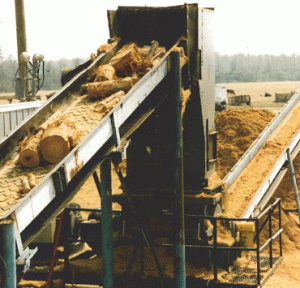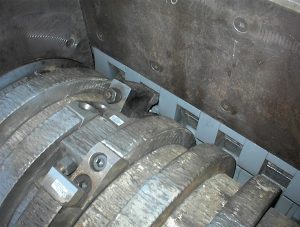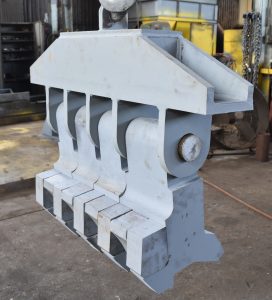Punch & Die Hogs – KC Cut
High Volume Biomass
 In 1946, W.T.S. Montgomery invented and patented the Punch and Die Hog as a better way to extract higher value out of a variety of waste materials. In the late 1950’s he took things up a notch as a project for the Kimberly-Clark Corporation. The KC Series was developed to process greater volumes of material with an increased tolerance for the kinds of heavy tramp metal contaminants typcially found in the mill.
In 1946, W.T.S. Montgomery invented and patented the Punch and Die Hog as a better way to extract higher value out of a variety of waste materials. In the late 1950’s he took things up a notch as a project for the Kimberly-Clark Corporation. The KC Series was developed to process greater volumes of material with an increased tolerance for the kinds of heavy tramp metal contaminants typcially found in the mill.
Cost effective and rugged, it quickly set the standard in producing efficient burn biomass for pulp and paper mills throughout the United States.
KC applications now include bark, mulch, plywood, particleboard, thick slabs and log butts, charcoal, railroad cross ties, pallets, light aluminum and copper scrap, corrugated paper, oil shale, industrial trash, automobile tires and tightly wound paper rolls and cores.
Across a broad spectrum of applications, it’s hard to beat the proven results of Montgomery.
The Punch and Die System
An Efficient Two-Stage Grind Using Only One Machine
 The Punch and Die System provides a two-stage grind in a single machine. The first grind occurs when a set of rotating teeth (hammers) punch material through a series rectangular pockets formed by stationary dies (anvils). The teeth are secured to a spinning rotor assembly.
The Punch and Die System provides a two-stage grind in a single machine. The first grind occurs when a set of rotating teeth (hammers) punch material through a series rectangular pockets formed by stationary dies (anvils). The teeth are secured to a spinning rotor assembly.
 The anvils are comprised of anvil points bolted to massive holders that are pinned to the side of the machine. The combination provides a deep pocket for the first stage cut.
The anvils are comprised of anvil points bolted to massive holders that are pinned to the side of the machine. The combination provides a deep pocket for the first stage cut.
A pattern of high and low teeth with large and small anvils keeps material moving with nowhere to hide, allowing the hog to rapidly process material with relentless efficiency. The KC cut employs three inch wide cutting teeth grinding against three inch wide stationary anvils. An overlap cut is built into the design to allow the successful processing of even soft, spongy or stringy material.
The second grind occurs after the material has been processed past the anvils and directed downward across a curved sizing screen. The screen openings can be made of various shapes and sizes to customize the end product. Steel bars (baffles) are typically added on larger sized holes to control the length of material that is allowed to get through. Baffles can be applied in varying configurations in order to optimize throughput while avoiding unwanted sticks and slivers that can clog pipes, jam screw conveyors, reduce boiler efficiency or degrade the salability of mulch.
When grinding bark for hogged fuel and for other coarse breakdown applications, a solid baffle screen with rectangular openings can be used to increase throughput and drive efficiency.
Hardsurfacing is applied to the leading edges and cutting surfaces to increase durability and extend economic life.
With a large number of screen configurations available, a Montgomery Hog can be adapted to variations in process requirements, including the seasonal rise and fall of moisture content in freshly harvested wood.
All screens are designed for easy removal and replacement.
Tramp Metal Protection
External Shear Bolts
In addition to assuring longer life, the rugged construction of a Montgomery Hog allows it to process light metal (1/4 inch and thinner), nails, small bolts and steel strapping.
Should something more substantial come between the teeth and anvil points, External Shear Bolts are used to protect the hog and mitigate the potential for damage.
The anvil points are bolted to a series of anvil holders that are individually secured to the lower housing and held in position by 1” diameter brass shear bolts. The shearing strength of each bolt is sufficient to carry loads encountered during normal operation but will shear if heavy tramp metal enters the hog, allowing the anvil holder to pivot away from the cutting chamber.
The pivoting anvil holder pushes outward on a screen trip latch mechanism, shearing the bolt on the locking bar that holds the trip latch in position. As the trip latch pivots away from the rotor, the hinged screen under the rotor drops away, allowing the tramp steel to clear the machine.
The pivoting trip latch also triggers a limit switch attached to the lower housing. The limit switch signal can be wired to shut down the hog and its infeed conveyor. It can also be wired to activate visual and/or audible signaling devices to alert operating personnel that the latch has tripped and requires resetting.
A hydraulic reset mechanism is available to provide mechanical advantage to pivot the screen back into position and facilitate easy resetting of the screen.
Anticipating Wear
Protecting Your Investment
Processing high volumes of material with sandy or abrasive contaminates can act like a sandblasting operation on steel. In addition to welded hardsurfacing on the teeth, anvil points, anvil holders, screen, ring lugs and ring perimeters (optional), all KC Model Hogs incorporate abrasion resistant wear liners on all four sides of the cutting chamber. Like the other routine wear items on the hog, the wear liners are securely bolted into position but can be removed and replaced as needed.